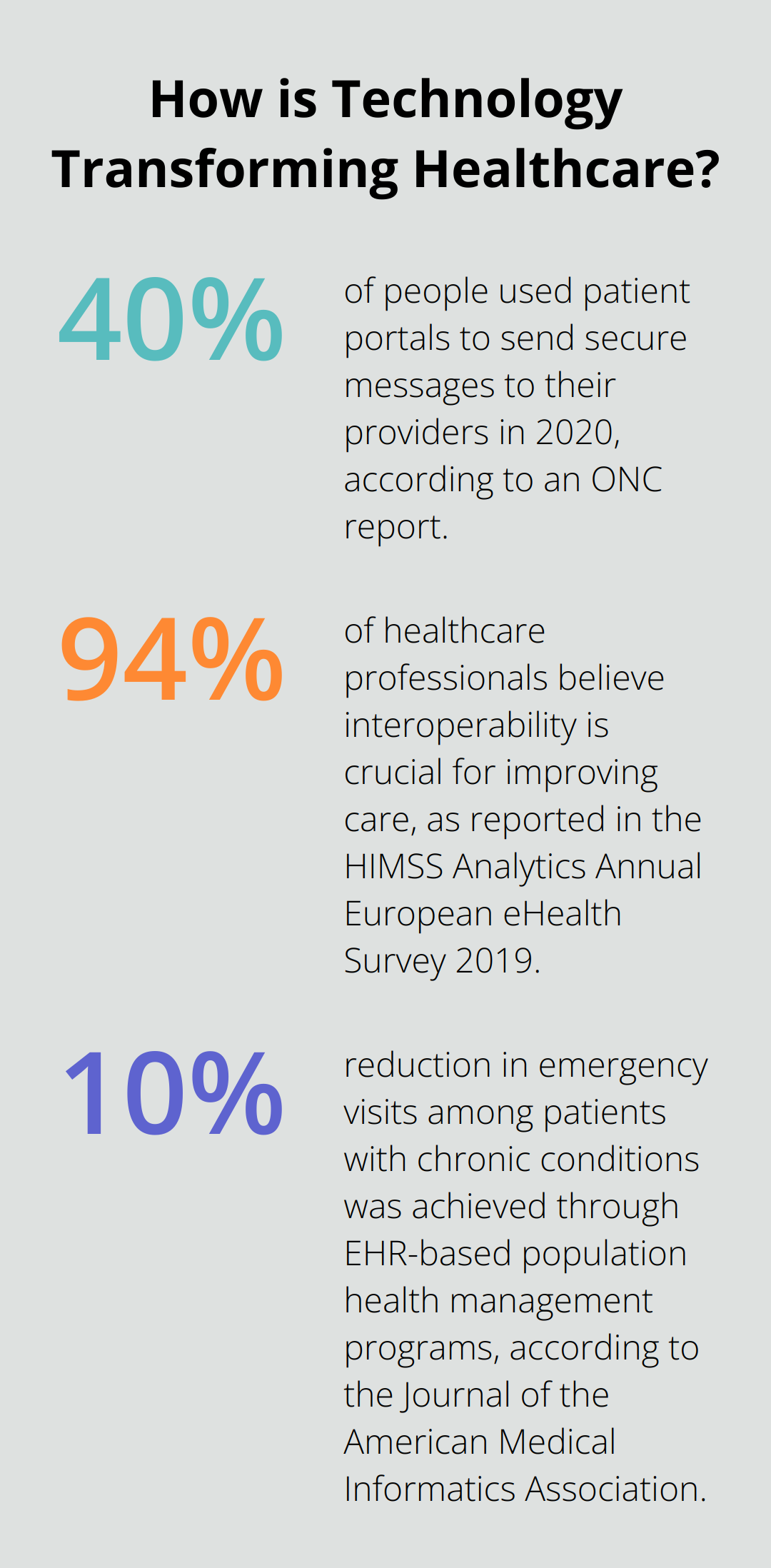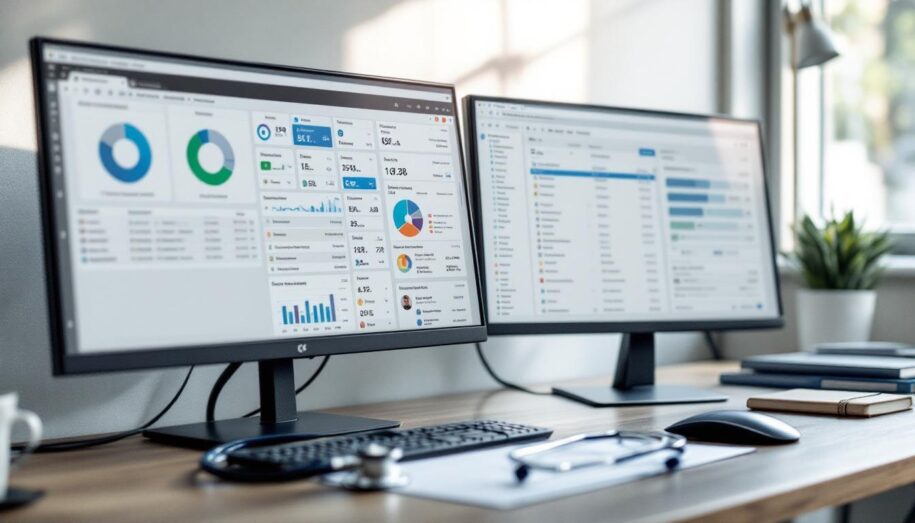Two terms that muddle minds in healthcare tech — EHRs and EMRs. What’s the deal? At ScriberJoy, we’re bombarded with questions… “What’s the difference between Electronic Health Records and Electronic Medical Records?” It’s time to break it down, folks.
We’re diving into these concepts, weighing their perks (and yep, the headaches) that healthcare providers grapple with when swapping systems. Plus, let’s want a glimpse into the crystal ball — future trends that’ll steer electronic health info management. Get comfy.
EHRs vs EMRs: Navigating the Digital Health Record Maze
EMRs: The Digital Patient Chart… Basically
Okay, so Electronic Medical Records (EMRs) are like the souped-up digital versions of those ancient paper charts in a doctor’s office. Think of them as the go-to file on your medical history for a single practice. What do they do well? Let’s break it down:
- Tracking data over time (tick-tock, consistently)
- Catching patients due for their annual pokes and prods
- Boosting the quality of care in one place… nice

But here’s the rub – EMRs are homebodies. They don’t play well with outsiders. If you’re seeing a specialist elsewhere, your record likely takes a trip via snail mail (how very ‘90s).
EHRs: The Full Health Epic
Enter Electronic Health Records (EHRs) – the big picture pal. These bad boys cover more ground, pulling together data from every healthcare stop you’ve ever had. They’re built to share the love (aka info) with a sprawling array of healthcare players:
- Laboratories… check
- Specialists… check
- Medical imaging spots
- Pharmacies
- ER heroes
- School or workplace clinics – inclusivity, people!
Key Differences: Scope, Sharing, and Patient Bonding
The EMR vs. EHR showdown really boils down to scope and shareability. EMRs are the stay-at-home type, while EHRs are the world travelers. They assemble a 360°view of your health story by mingling data from multiple providers.
Plus, EHRs are all about patient power. Many offer gateways (a.k.a. portals) where you can:
- Peek at your health info anytime
- Book your next poking session
- Chirp with your healthcare team
A 2021 report from the Office of the National Coordinator for Health Information Technology announced that 86% of non-Federal general acute care hospitals had jumped on the 2015 Edition EHR bandwagon. Proof that the health record world is turning collaborative and tech-savvy.
The Impact on Healthcare Providers
For the folks in white coats, choosing between EMRs and EHRs can drastically level up their game:
- Workflow Wizardry: EHRs streamline processes by chatting with various systems (billing, anyone?).
- Coordination Expertise: EHRs connect the dots across different healthcare providers.
- Data Whiz: They offer beefy data analysis vibes, perfect for population health brainiacs.
- Patient Connection: EHRs typically up the ante with sleek patient engagement gadgets.
Shifting from EMRs to EHRs is like stepping into a future where healthcare’s more interlinked and patient-focused. But, oh boy, it comes with its own hurdles – a tale for another time!
Why EHRs Are Game-Changers for Healthcare
EHRs are shaking things up in healthcare-way beyond what those EMR relics ever did. They’re not just digital file cabinets but powerful machines driving a massive shift in how care is delivered and managed. And yeah, they’re game-changers.
Comprehensive Patient Care Across Providers
EHRs? They’re like a superpower for piecing together a patient’s health story. While EMRs are stuck on “one house, one roof,” EHRs haul data from coast to coast. A cardiologist chilling in New York can peek at notes from a primary doc in California without breaking a sweat.

According to this study, those real-time electronic notifications in EDs about high-risk patients are showing some oomph in juicing up healthcare utilization. This sort of coordination was more like sci-fi back in the EMR days.
Patient Empowerment and Engagement
Enter EHRs, and suddenly, patient engagement isn’t just a buzzword. Many EHR systems come with snazzy patient portals where folks can poke around their health records, book appointments, and ping their healthcare crew.
The ONC threw out a 2020 report stating that 40% of people used portals to fire off secure messages to their providers. A direct line like this? It’s like jet fuel for firing up health outcomes and ramping up patient happiness.
Interoperability and Data Sharing
EHRs are crushing it when it comes to data swapping across healthcare systems. This magical interoperability is key for keeping care coordinated, especially when you’re juggling patients with complex needs.
The HIMSS Analytics Annual European eHealth Survey 2019 spilled the beans that 94% of healthcare folks think interoperability is the MVP for improving care. EHRs are the champs making this happen, smoothing out care transitions, and slicing medical errors from sloppy or missing info.
Population Health Management
EHRs aren’t just about getting up close and personal with individual care. They’re armed and ready with tools to tackle population health on a grand scale. Pile up and crunch data from oodles of patients, and suddenly you’re spotting trends, predicting disease flares, and cooking up targeted interventions.
The Journal of the American Medical Informatics Association found that EHR-based programs in population health management knocked down emergency visits by 10% among chronic condition folks. That’s huge.
EHRs are reshaping healthcare from the ground up, but backing away from EMRs for the shiny EHR world isn’t without a snag or two. So, what bumps in the road are healthcare providers hitting on this transition trek? Let’s dive into it.
Navigating the EMR to EHR Transition Hurdles
Healthcare providers … ugh, the hurdles they face when jumping from Electronic Medical Records (EMRs) over to Electronic Health Records (EHRs). Now, this leap, it’s got benefits down the line, sure, but man, it comes with a flurry of obstacles that need some serious strategizing and planning.
The Price Tag Shock
Alright, the cost of EMR implementation– it’s a doozy. Custom solutions, we’re talking a fat $500,000 – $700,000 for mid-size players. And this isn’t just a software gig; you’ve got hardware to jazz up, staff to bring up to speed, and let’s not forget … that inevitable productivity dip during the big switch.

And about that dip: practices see a 15-20% slowdown in productivity for 3-6 months post-implementation. This blip (we’re talking like half a year) just stacks onto the financial weight of the transition.
Data Migration Nightmares
Now, shifting data from EMRs to EHRs? Welcome to technical purgatory. Systems speak in tongues (incompatible formats), turning data shifts into a messy tango.
A survey-brace yourself-showed 23% of practices ended up losing patient data during the switch. Ouch. This loss spells not just headaches but real risks to patient care. So, you better map out solid migration tactics. Choices? There’s good ol’ manual entry for the must-have info (time gobbler and error magnet) or spending more on super-special migration gizmos (pricey addition, am I right?).
The Human Factor
Let’s chat humans. Change resistance, it’s a biggie. Research said 43% of docs think EHRs are speed bumps under wheels, and 66% feel EHRs hog patient time.
Knocking down this wall needs beefy training programs. The Healthcare Information and Management Systems Society (HIMSS) pokes you to shell out 10% of the total EHR budget on training. This cash splash on schooling? Key to making the EHR puzzle fit.
Security and Compliance Tightrope
EHRs-data heaven. And cyber crooks? They’ve got EHRs in their crosshairs. Back in 2020, 642 healthcare breaches hit over 29 million records Stateside.
Juggling HIPAA rules while bringing in an EHR system-it’s like walking a tightrope. Regulations are a moving target, pushing providers to possibly hire compliance officers or consultants, adding layers to our transition drama.
But hey, even with these roadblocks, the perks of EHRs, down the road, usually squash the initial grumbles. Healthcare pros must tackle this leap with sharp planning, solid budgeting, and non-stop support to ace the jump from EMRs to EHRs.
Final Thoughts
Alright, folks, let’s break it down. The gap between Electronic Health Records (EHRs) and Electronic Medical Records (EMRs) – consider it clarified. EHRs? They’re your all-access pass, records you can toss around between providers like a hot potato. EMRs? Think of them as the digital version of that old-school paper chart stuck in a single doctor’s office. The swing towards EHRs? It’s like moving from dial-up to fiber optics in terms of healthcare tech – big league. As of 2021, 86% of non-Federal general acute care hospitals were flexing those 2015 Edition EHR muscles.

What’s on the horizon? EHRs are gonna be the rock stars of healthcare with their smooth-as-butter interoperability and fancy analytics tricks. Picture a world where your health data zips across systems like a high-speed train, fueling sharper, data-packed decisions. Toss AI and machine learning into the EHR mix, and suddenly, you’re looking at a future where personalized medicine isn’t just a buzzword, and automated clinical decisions are as common as cat videos on the internet.
As the healthcare industry dives deeper into digital waters, nailing down precise and efficient documentation is clutch. Enter ScribeJoy – think of it as your trusty sidekick for creating spot-on medical records. It’s got the AI brainpower paired with human oversight, letting healthcare pros get back to what they do best: treating patients, not drowning in paperwork. The result? A major boost in healthcare’s efficiency and effectiveness. Now that’s some good medicine.

Leave a Reply
You must be logged in to post a comment.